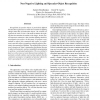Free Online Productivity Tools
i2Speak
i2Symbol
i2OCR
iTex2Img
iWeb2Print
iWeb2Shot
i2Type
iPdf2Split
iPdf2Merge
i2Bopomofo
i2Arabic
i2Style
i2Image
i2PDF
iLatex2Rtf
Sci2ools
ICCV
2005
IEEE
2005
IEEE
Non-Negative Lighting and Specular Object Recognition
Recognition of specular objects is particularly difficult because their appearance is much more sensitive to lighting changes than that of Lambertian objects. We consider an approach in which we use a 3D model to deduce the lighting that best matches the model to the image. In this case, an important constraint is that incident lighting should be non-negative everywhere. In this paper, we propose a new method to enforce this constraint and explore its usefulness in specular object recognition, using the spherical harmonic representation of lighting. The method follows from a novel extension of Szego’s eigenvalue distribution theorem to spherical harmonics, and uses semidefinite programming to perform a constrained optimization. The new method is faster as well as more accurate than previous methods. Experiments on both synthetic and real data indicate that the constraint can improve recognition of specular objects by better separating the correct and incorrect models.
Computer Vision | ICCV 2005 | Specular Object Recognition | Specular Objects | Spherical Harmonics |
| Added | 24 Jun 2010 |
| Updated | 24 Jun 2010 |
| Type | Conference |
| Year | 2005 |
| Where | ICCV |
| Authors | Sameer Shirdhonkar, David W. Jacobs |
Comments (0)

